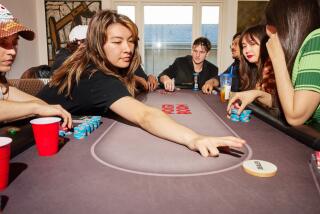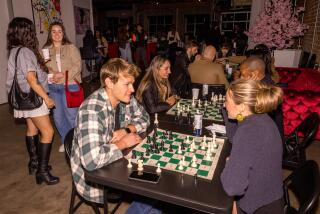At Mah-Jongg Table, Hands Play Poetry
- Share via
The Jewish Joy Luck Club, as it is listed in the class catalog, is meeting. Looking somewhat befuddled, 34 women and two men sit around tables in a University of Judaism classroom.
Carol Kaiserman--wearing sneakers so as to move swiftly from table to table--is explaining the basics of mah-jongg. “To start, we wash the tiles, which means we smush them around.” A great clattering fills the room as people shuffle their tiles face down on the tables.
Founder of the West L.A.-based Mah-Jongg Network, Kaiserman teaches beginners and intermediates and helps them find ongoing groups. To her, this ancient game is a thing of beauty. The game words that roll off her tongue--”kong,” “pung”--sound like Chinese takeout to those who don’t speak the language.
The Chinese invented the game, possibly about 500 BC, giving it a name like “ma chiang.” Around 1920, American traveler Joseph P. Babcock brought it home, gave it Western rules and a vocabulary based roughly on transliterations of the Chinese and patented it as maj-jongg. Thus began a boom.
“At that time, the game was strictly elitist,” says Ruth Unger, president of the New York-based National Mah Jongg League (founded in 1937). “On 5th Avenue, many a mansion had a room just for mah-jongg.” In time, the frenzy faded, but devotees endured. Among mah-jongg lovers past and present she lists Mamie and Ike, Jackie Gleason and Tom Seaver.
Generations of American women of a certain age grew up watching their mothers play. Today they’re part of a renaissance fed both by the 1993 film “The Joy Luck Club” and the explosion of an aged population with leisure time.
“I can account for at least a quarter of a million players, and I’m sure there are a lot more,” Unger says. Most live in Florida, but California’s a Top 10 state.
Modern mah-jongg is played with 152 little rectangular tiles (plastic, not ivory these days). The tiles, replete with Asian symbolism about winds and seasons and ancient walls, depict birds, flowers, dragons.
“So sensual,” says Kaiserman, caressing the tiles, “putting our hands in and hearing the click and feeling connected to the rest of the world that plays this game.” She’s explaining the buzzwords: A “pung” is three of a kind, a “kong,” four of a kind. “Think King Kong,” as in “big” hand, she suggests.
The object of the game--which is gin rummy’s second cousin--is fairly simple: to acquire certain sets or combinations of tiles and to be first to go out or “mah-jongg.” This means derailing the opponents along the way.
Bridge has spades, hearts, diamonds, clubs. Pretty straightforward. Mah-jongg suits are bams (bamboos), dots (circles) and craks (Chinese characters). Then there’s a white dragon called, for some bizarre reason, “soap.” As if this weren’t enough, one tile-passing maneuver is dubbed a Charleston.
Although devotees insist the game is not cutthroat, Kaiserman mentions that “most people do play for money.” Still, she prefers to think of mah-jongg in terms of poetry and rhythm.
The official game card issued each spring by the national league is the bible of mah-jongg, with its new combinations of 50 hands and their point values. “The Asians had one game that’s lasted 2,000 years. But Americans need diversion, new challenges, change,” Unger says. Among American fillips: addition of eight jokers--all wild.
From August through November, Unger and 10 other women play six hours a day, three days a week, testing and amending combinations of hands she’s devised. Nonetheless, she observes, “Many people think we throw this into a computer and have it spit out 50 hands.”
Of course, one can play with outdated cards. But buying a new card for $4.50--and buying it directly from the league--makes one a member. Among the perks: someone to call to resolve disputes.
Around Southern California, there are numerous ongoing classes, including one at Valley Storefront, Jewish Family Service, in North Hollywood, where, teacher Ellen Fanale says, mah-jongg is “extremely popular” with the 60-and-over set.
Game stores from Westwood to Costa Mesa report steady sales of sets priced from $35 to $125. Says Ralph Ramirez, manager of the Game Keeper in Glendale: “We used to get people in every month asking for mah-jongg. Now we get them in every day. We’re starting to have younger people asking.” Used sets do show up at garage sales but often have missing or faded tiles.
To novices, the game seems like, well, reading Chinese. But, Kaiserman says, “If they can just sit it out for the first two lessons, somebody else will pull them along.” And it’s fast--a game can whiz by in 10 minutes from roll of the dice to “mah-jongg.” “If you snooze for even a second, you’re lost,” Kaiserman says.
Back at the Jewish Joy Luck Club, one woman is about to throw in her tiles when a neighbor at the table offers this encouragement: “Look, did you ever learn to drive a stick shift car?”
Unlike in Asia--where once a prospective son-in-law might be judged by his behavior at the mah-jongg table--virtually all American players are women. “There is a stigma that it’s a woman’s game,” Unger says. The league’s annual Caribbean cruise draws 300, virtually all women. Its major charity is woman-oriented, the Mt. Sinai Hospital Breast Center.
Mah-jongg computer games have arrived, not a fact that thrills Unger. This is supposed to be a sociable game of two to four players, even though it’s each player for herself--and silence, please. “I feel sorry for them,” Unger says of those sitting solo at their monitors. Where is the bonding? The “magic of the tiles that releases your tensions?”
Kaiserman, a self-described game nut who discovered mah-jongg a decade ago, says, “This game is so hypnotic, you can even forget ‘Seinfeld.’ These women are fanatics once they get started.”
As if to make the point, a first-timer returns, breathless, a few minutes after leaving the Jewish Joy Luck Club. She explains, “I got so excited over winning, I forgot my purse.”
More to Read
Sign up for our Book Club newsletter
Get the latest news, events and more from the Los Angeles Times Book Club, and help us get L.A. reading and talking.
You may occasionally receive promotional content from the Los Angeles Times.








